This document describes how to set up multi-factor authentication (MFA) for your WatchGuard accounts with Duo and AuthPoint.
Duo Single Sign-On is a cloud-hosted Single Sign-On solution. In this integration, Duo integrates with WatchGuard AuthPoint (IdP) and WatchGuard Account (SP). WatchGuard AuthPoint provides the primary authentication and Duo SSO completes the secondary authentication.
Contents
WatchGuard Account Authentication Data Flow with Duo and AuthPoint
This diagram shows the data flow of an MFA transaction for WatchGuard Cloud.
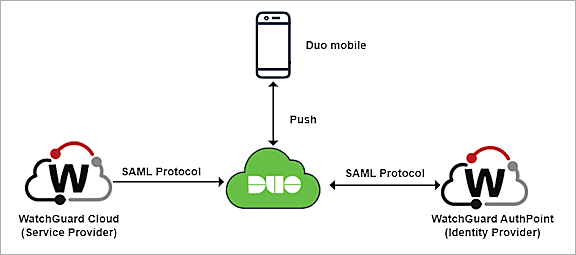
Before You Begin
Before you begin these procedures, make sure that:
- A token is assigned to a user in Duo mobile.
- You have a tier-1 WatchGuard Cloud account and an operator with the Owner or Administrator role.
- You have an AuthPoint identity provider (IdP) certificate (go to Certificate Management).
Additional charges might apply to use Duo.
Configure Duo
To configure Duo, complete these steps:
- Configure AuthPoint as an Identity Provider in Duo.
- Configure WatchGuard Account as a Service Provider in Duo
Configure AuthPoint as an Identity Provider in Duo
To configure AuthPoint as an identity provider in Duo, you must:
- Download the metadata file from the AuthPoint management UI.
- Configure AuthPoint as an identity provider in Duo.
To download the metadata file from the AuthPoint management UI:
- Log in to WatchGuard Cloud.
- From the navigation menu, select Configure > AuthPoint. If you have a Service Provider account, you must select an account from the Account Manager.
- Select Resources.
The Resources page opens.

- Click Certificate.
The Certificates page opens.
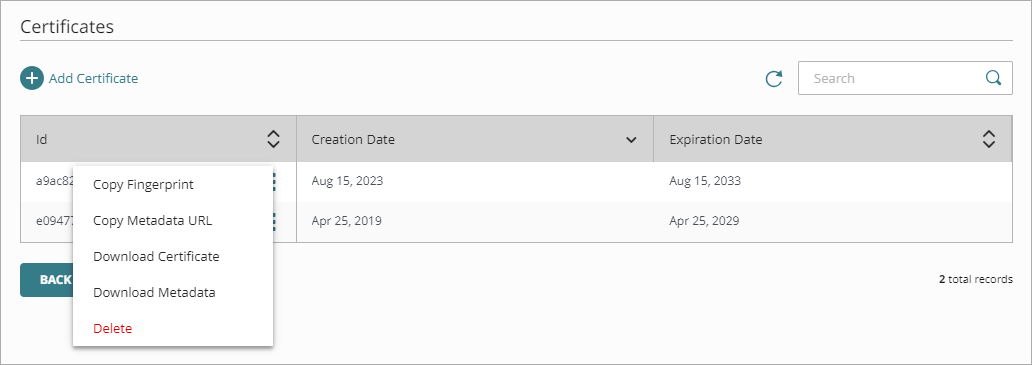
- Next to the AuthPoint certificate you want to associate with your resource, click
 , then select Download Metadata and Download Certificate. We recommend that you select the certificate with the latest expiration date.
, then select Download Metadata and Download Certificate. We recommend that you select the certificate with the latest expiration date. - Open the metadata file and copy the entityID, SingleLogoutService Location, and SingleSignOnService Location values. You need this information when you configure AuthPoint as an identity provider in Duo.
To configure AuthPoint as an identity provider in Duo:
- Log in to the Duo Admin Panel.
- From the navigation menu, select Single Sign-On.
The Add Authentication Source page opens.
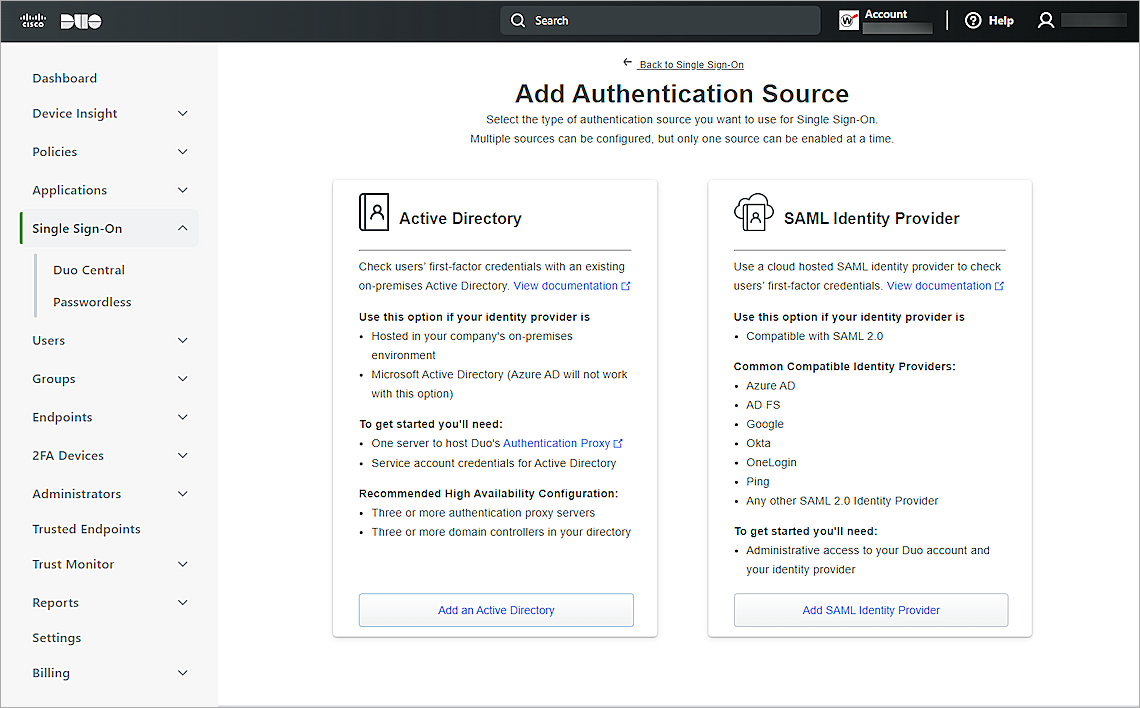
- Click Add SAML Identity Provider.
The SAML Identity Provider Configuration page opens.
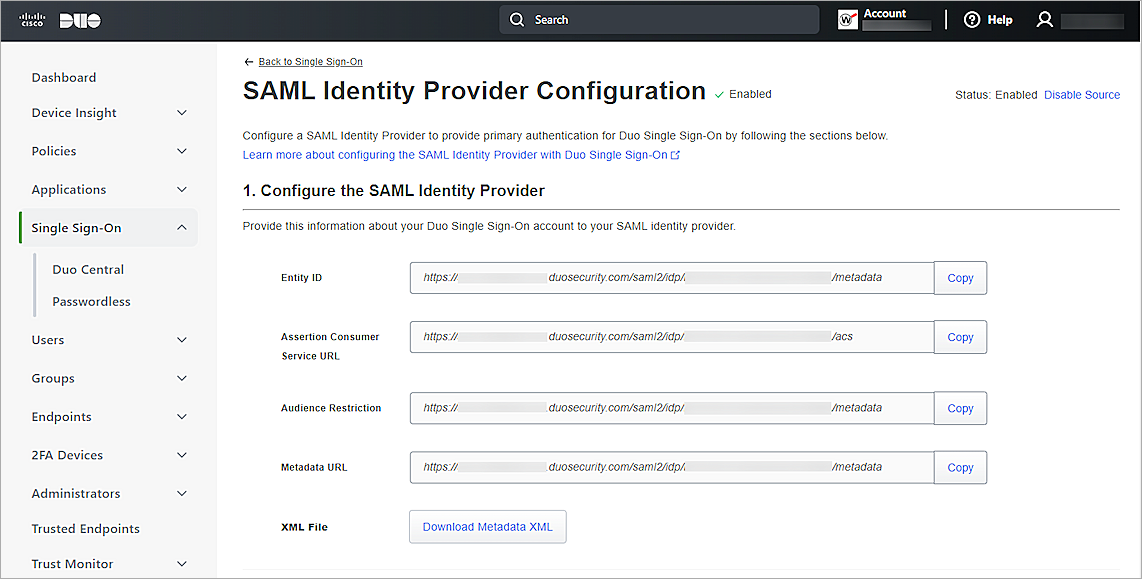
- From the 1. Configure the SAML Identity Provider section, copy the values of the Entity ID and Assertion Consumer Service URL parameters. You need this information when you configure AuthPoint.
- Scroll down to the 3. Configure Duo Single Sign-On section.
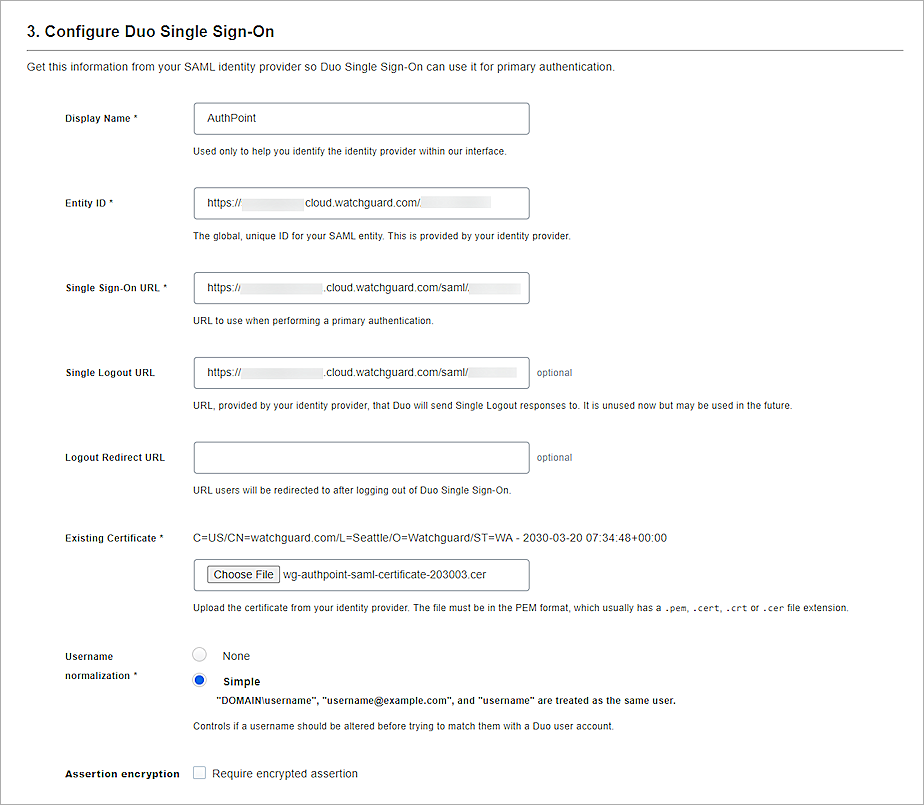
- In the Display Name text box, type a name.
- In the Entity ID text box, type or paste the entityID value you copied from the AuthPoint metadata file in this section.
- In the Single Sign-On URL text box, type or paste the SingleSignOnService Location value you copied from the AuthPoint metadata file in this section.
- In the Single Logout URL text box, type or paste the SingleLogoutService Location value you copied from the AuthPoint metadata file in this section.
- To upload the certificate from your identity provider, click Choose File and upload the AuthPoint certificate you downloaded in this section.
- Keep the default values for other settings.
- Click Save.
Configure WatchGuard Account as a Service Provider in Duo
To configure WatchGuard account as a service provider in Duo, you must:
- Copy the WatchGuard Service Provider SAML Metadata URL from the WatchGuard Account SSO Configuration Wizard.
- Configure WatchGuard account as a service provider in Duo.
To copy the WatchGuard Service Provider SAML MetadataURL:
- Log in to WatchGuard Cloud with your WatchGuard user account credentials.
- Select Administration > SSO.
The SAML SSO page opens.
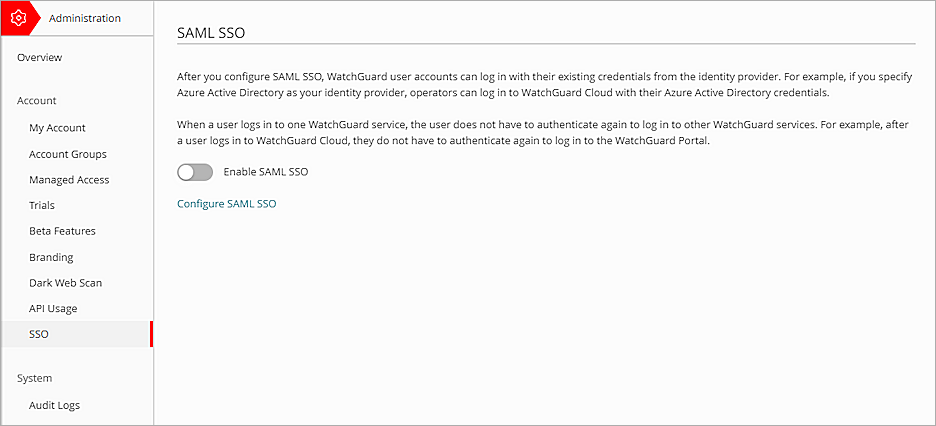
- Click Configure SAML SSO.
- Click Continue.
The WatchGuard Account SSO Configuration Wizard page opens.
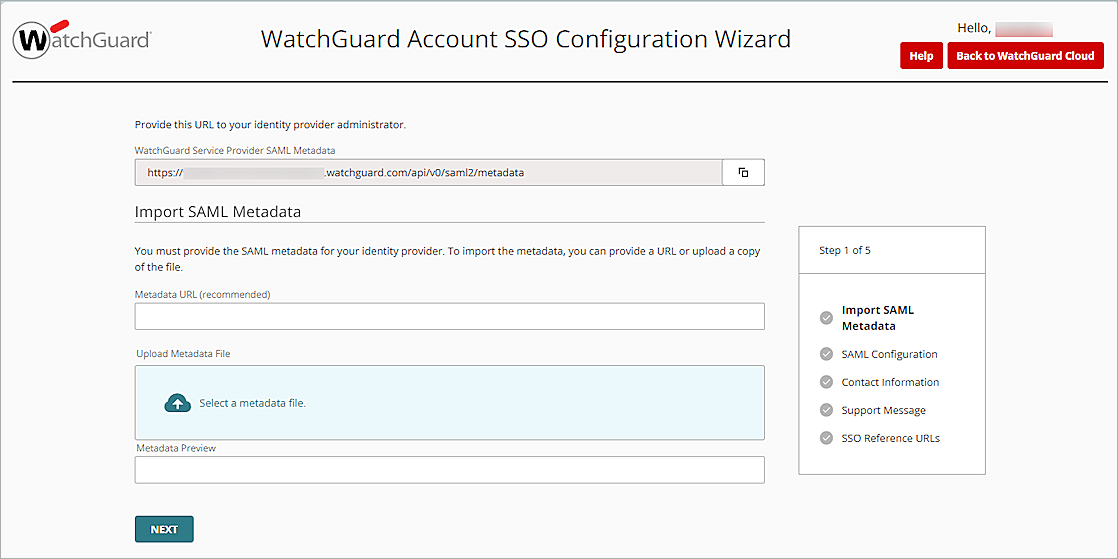
- In the WatchGuard Service Provider SAML Metadata text box, copy the WatchGuard Service Provider SAML Metadata URL.
- To open the WatchGuard Service Provider SAML metadata file, on a new tab on your web browser, enter the WatchGuard Service Provider SAML Metadata URL you copied in the previous step.
- From the WatchGuard Service Provider SAML Metadata file, copy the entityID, SingleLogoutService Location, and AssertionConsumerService Location values. You need this information when you configure WatchGuard account as a service provider in Duo.
To configure WatchGuard account as a service provider in Duo:
- Log in to Duo Admin Panel.
- From the navigation menu, select Applications > Protect an Application.
The Protect an Application page opens.

- From the application list, find Generic SAML Service Provider, then click Protect.
The Generic SAML Service Provider - Single Sign-On page opens.
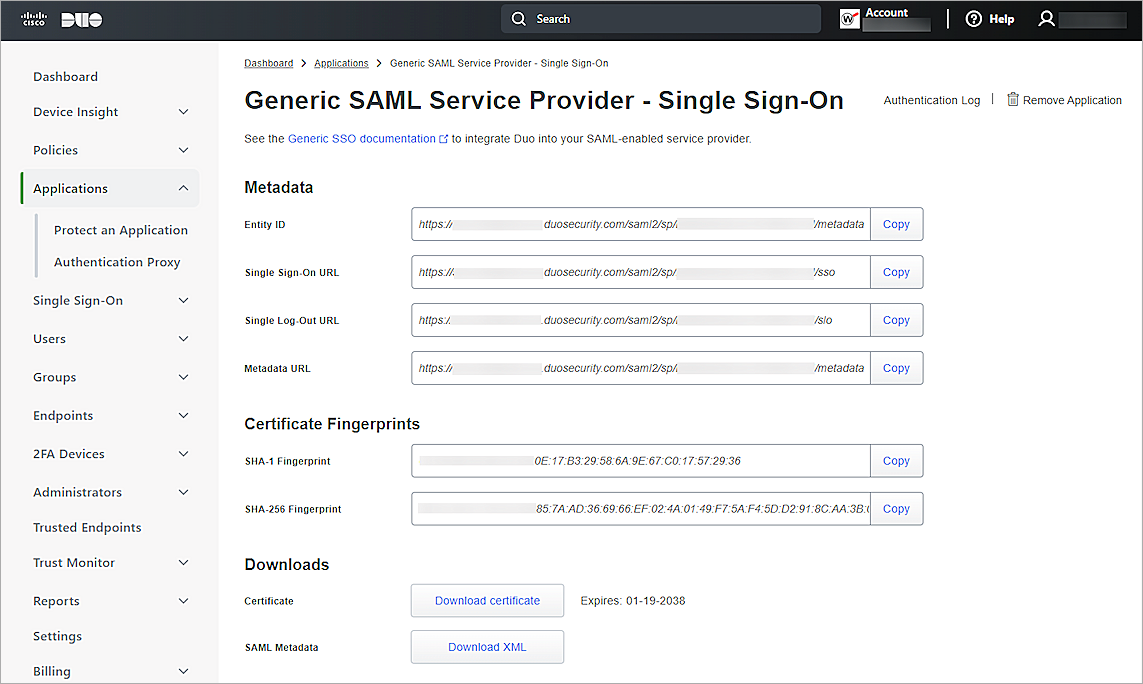
- From the Metadata section, in the Metadata URL text box, copy the metadata URL. Or to download the metadata file, click Download XML. You need this information when you configure SSO for your WatchGuard Account.
- Scroll down to the Service Provider section.
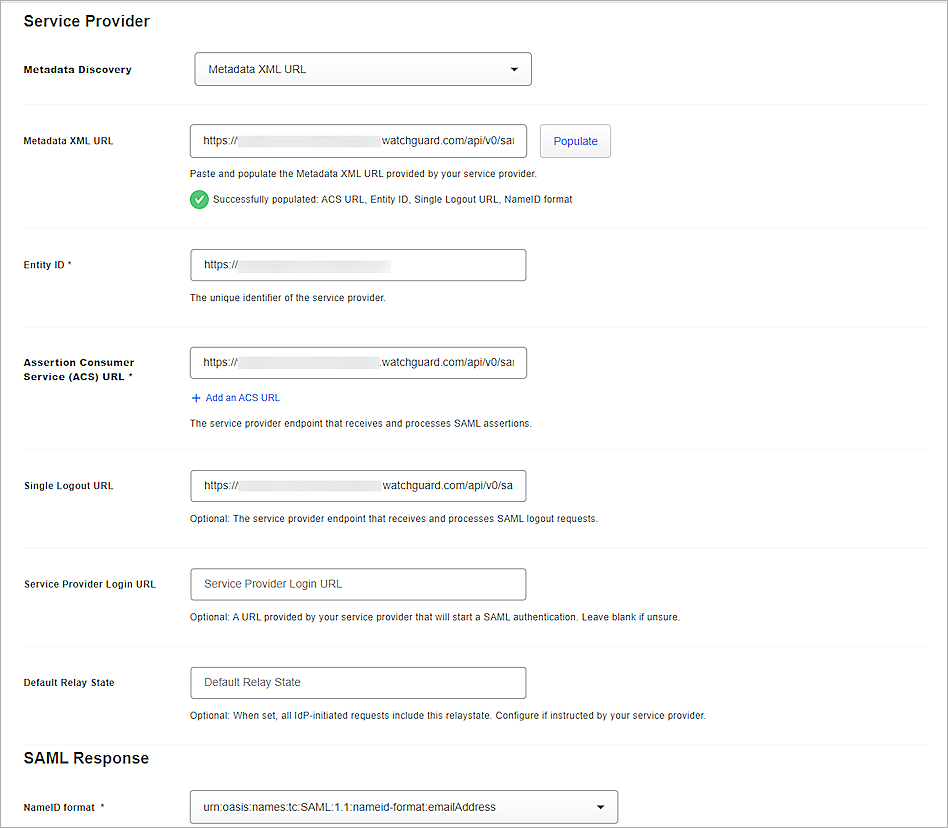
- From the Metadata Discovery drop-down list, select None (Manual Input), Metadata XML URL or Metadata XML File. In this example, we select Metadata XML URL).
If you select None(Manual Input), type or paste the Entity ID, Assertion Consumer Service (ACS) URL and Single Logout URL values you copied from the WatchGuard Service Provider SAML metadata file in this section. - In the Metadata XML URL text box, type or paste the WatchGuard Service Provider SAML metadata URL you copied in this section, then click Populate.
The ACS URL, Entity ID, Single Logout URL, and NameID Format values fill in automatically. - Keep the default values for other settings.
- Click Save.
Configure SSO for Your WatchGuard Account
To configure SSO for your WatchGuard account:
- On the WatchGuard Account SSO Configuration Wizard page, in the Metadata URL text box, type or paste the metadata URL you copied in the previous section. If you download the Duo Generic SAML Service Provider metadata file, click Select a Metadata File and upload the metadata file you downloaded.
- Click Next.
The SAML Configuration options open.
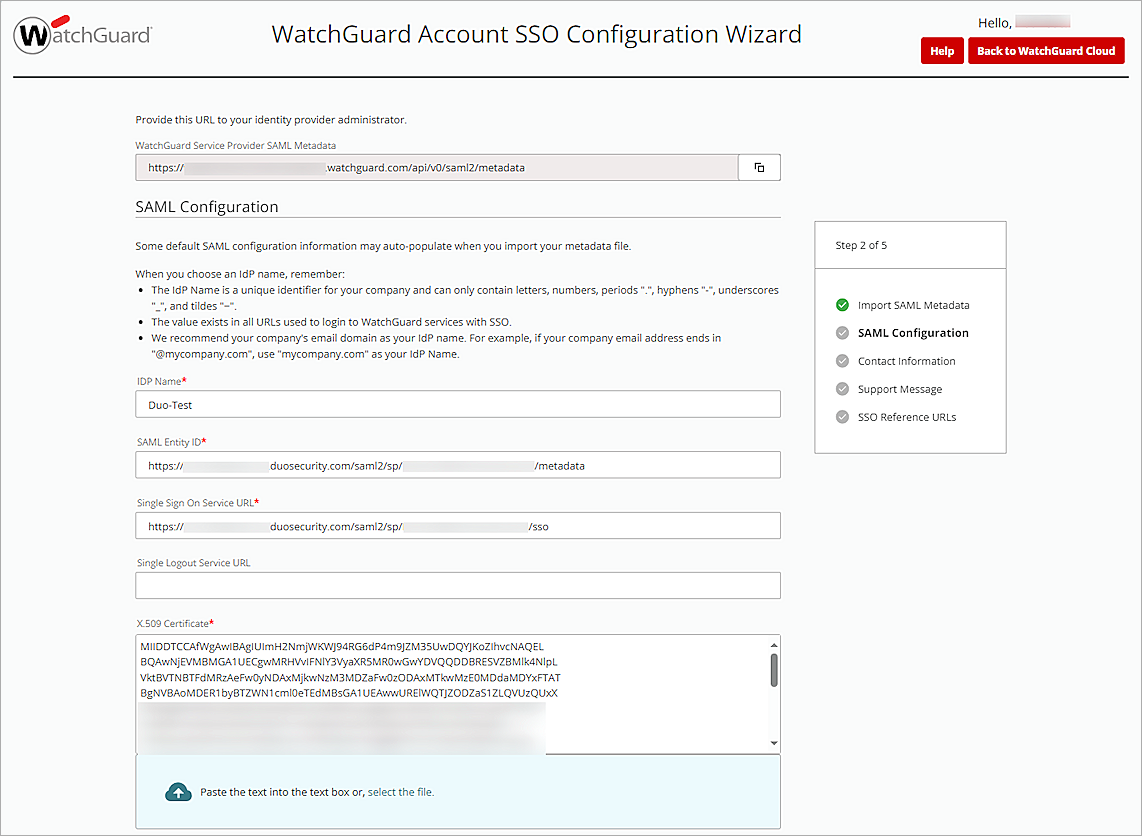
- In the IDP Name text box, type the IDP name. In our example, we use Duo-Test.
- Leave the default values for other settings.
- To proceed through the Contact Information, Support Message and the SSO Reference URLs pages, click Next three times.
The SSO Reference URLs page opens.The SSO reference URLs provide you with the direct links to the SSO log in pages for each account.
- Click Save.
- Click Back to WatchGuard Cloud.
- Select
 > My Account.
> My Account. - Select SSO. Make sure the Enable SAML SSO toggle status is green.
- To add the operators in WatchGuard Cloud, follow the steps in Add Operators to your Account.
After you add an operator, make sure the Enable Login With SAML SSO check box is selected.
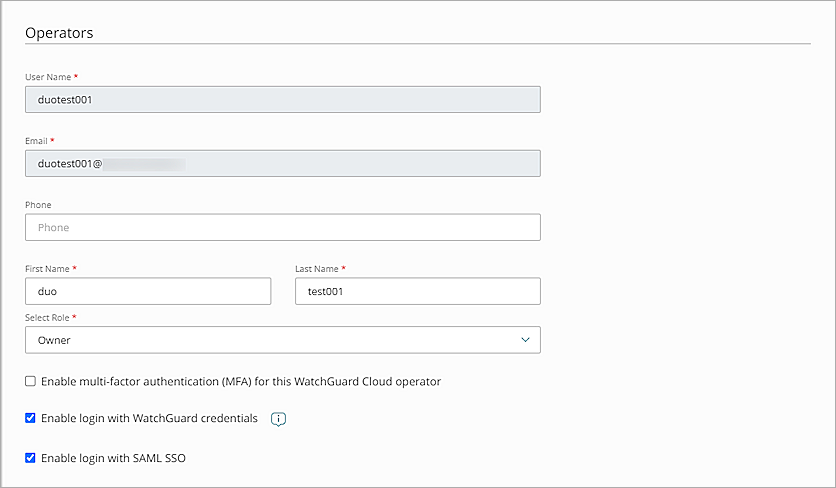
To log in with SSO, you must have a WatchGuard Cloud operator account and a Duo user account synced from Active Directory. Both user accounts must have the same email address.
When you configure SAML SSO for your WatchGuard account, users can either log in with SSO or with their local user account. We recommend users log in with SSO so they do not have to re-authenticate after their initial login.
Configure AuthPoint
To configure AuthPoint:
- Add a SAML Resource in AuthPoint.
- Add a Group in AuthPoint.
- Add an Authentication Policy to AuthPoint.
- Add Users to AuthPoint
Add a SAML Resource in AuthPoint
From the AuthPoint management UI:
- From the navigation menu, select Resources.
Click Add Resource.
The Add Resource page opens.

- From the Type drop-down list, select SAML.
Additional fields appear.

- On the SAML page, in the Name text box, type a name for this resource.
- From the Application Type drop-down list, select Others.
- In the Service Provider Entity ID text box, type or paste the entityID value you copied in the previous section.
- In the Assertion Consumer Service text box, type or paste the AssertionConsumerService Location value you copied in the previous section.
- From the User ID Sent On Redirection To Service Provider drop-down list, select Email.
- From the Signature Method drop-down list, select SHA-256.
- From the AuthPoint Certificate drop-down list, select the certificate to associate with your resource. This must be the same certificate that you downloaded the metadata for in the previous section.
- From the Custom Attributes section, click Add Attribute.
- In the Attribute Name text box, type Email.
- From the Get Value From drop-down list, select User Email.
- Click Save.
Add a Group in AuthPoint
You must have at least one user group in AuthPoint. If you already have a group, you do not have to add another group.
To add a WatchGuard Cloud-hosted group to the WatchGuard Cloud Directory:
- Go to Configure > Directories and Domain Services.
- Click the WatchGuard Cloud Directory domain name. If you have not yet added the WatchGuard Cloud Directory, click Add Authentication Domain and select the WatchGuard Cloud Directory.
The New Group page appears.

- In the Groups tab, click Add Group.
- In the Group Name text box, type a descriptive name for the group.
- (Optional) In the Description text box, type a description of the group.

- Click Save.
Your group is added to the WatchGuard Cloud Directory and to AuthPoint.
Add an Authentication Policy to AuthPoint
Authentication policies specify which resources users can authenticate to.
You must have at least one authentication policy in AuthPoint that includes the WatchGuard resource. If you already have authentication policies, you do not have to create a new authentication policy. You can add this resource to your existing authentication policies.
Users that do not have an authentication policy for a specific resource cannot authenticate to log in to that resource.
To configure an authentication policy:
- From the navigation menu, select Authentication Policies.
- Click Add Policy.
The Add Policy page opens.
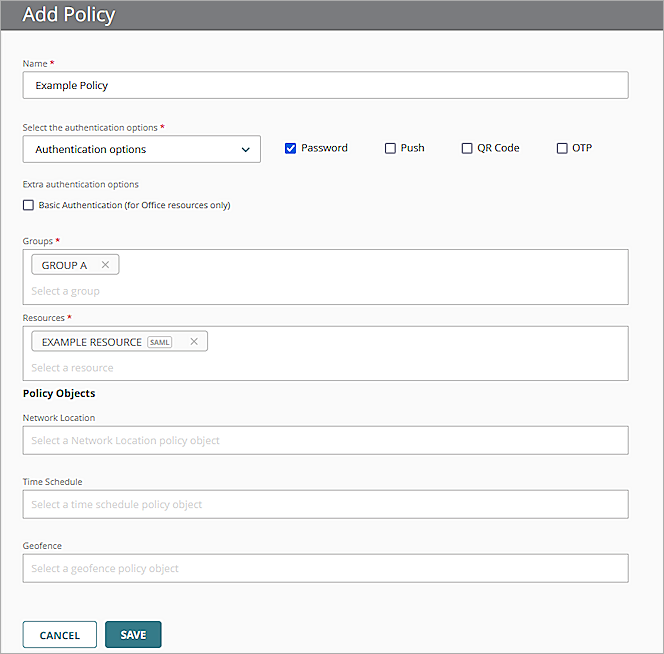
- In the Name text box, type a name for this policy.
- From the Select the Authentication Options drop-down list, select Authentication Options, then select the Password check box.
- In the Groups option, select which groups this policy applies to. You can select more than one group. To configure this policy to apply to all groups, select All Groups.
- In the Resources option, select the resource that you created in the Add a SAML Resource in AuthPoint section. If you want this policy to apply to additional resources, select each resource this policy applies to. To configure this policy to apply to all resources, select All Resources.
- (Optional) If you have configured policy objects such as Network Location, select which policy objects apply to this policy. When you add a policy object to a policy, the policy only applies to user authentications that match the conditions of the policy objects. For example, if you add a Network Location to a policy, the policy only applies to user authentications that come from that Network Location. Users who only have a policy that includes a Network Location do not get access to the resource when they authenticate outside of that Network Location (because they do not have a policy that applies, not because authentication is denied).
- Click Save.
Your policy is created and added to the end of the policy list.
When you create a new policy, we recommend that you review the order of your policies. AuthPoint always adds new policies to the end of the policy list.
Add Users to AuthPoint
Before you assign users to a group, you must add the users to AuthPoint. There are two ways to add AuthPoint user accounts:
- Sync users from an external user database
- Add WatchGuard Cloud-hosted AuthPoint users
Each user must be a member of a group. You must add at least one group before you can add users to AuthPoint.
To import users from Active Directory, Microsoft Entra ID, or an LDAP database, you must add an external identity in the AuthPoint management UI. External identities connect to user databases to get user account information and validate passwords.
- To sync users from Active Directory or an LDAP database, you must add an LDAP external identity
- To sync users from Microsoft Entra ID, you must add a Microsoft Entra ID external identity
When you sync users from an external user database, you can sync any number of users and they are all added to AuthPoint at one time. Users synced from an external user database use the password defined for their user account as their AuthPoint password.
To learn how to sync users, go to Sync Users from Active Directory or LDAP and Sync Users from Azure Active Directory.
You create WatchGuard Cloud-hosted users and groups from the WatchGuard Cloud Directory in WatchGuard Cloud. Directories and Domain Services is where you add shared authentication domains for WatchGuard Cloud devices and services, such as AuthPoint.
Users that you add to the WatchGuard Cloud Directory are automatically added to AuthPoint as well.
You add local AuthPoint users form Directories and Domain Services. You manage the users in AuthPoint on the Users page.
When you add WatchGuard Cloud-hosted AuthPoint users, you choose whether the user is an MFA user or a non-MFA user.
- MFA users are user accounts that will use AuthPoint multi-factor authentication to authenticate. This is not related to the AuthPoint Multi-Factor Authentication license type.
- Non-MFA users are users that will only ever authenticate with a password, such as a service account user. Non-MFA users do not consume an AuthPoint user license and cannot authenticate to resources that require MFA. They can only authenticate to protected resources if the non-MFA user account has a password only authentication policy for that resource.
After you add a user, you can edit the user account if you need to change their account type. When you change a user account from MFA to non-MFA, AuthPoint deletes the tokens and password vault (if applicable) that belong to the user. This action cannot be undone.
Unlike users synced from an external user database, WatchGuard Cloud-hosted AuthPoint users define and manage their own AuthPoint password. When you add a WatchGuard Cloud-hosted user account, the user receives an email that prompts them to set their password.
To learn how to add WatchGuard Cloud-hosted AuthPoint user accounts to the WatchGuard Cloud Directory, go to Add Local Users to an Authentication Domain.
Test the Integration
To test Duo MFA with your WatchGuard Account, you can select any method (push, Passkey, or Phone call).
In this example, we show the push authentication method (users receive a push notification in the mobile app that they must approve to authenticate).
If you do not create a user in Duo, the user is automatically created in Duo when you log in to WatchGuard Cloud with SSO.
- In a web browser, go to WatchGuard Cloud.
- Click Log In With SSO.
- In the IDP Name text box, type the IDP name.
- Click Log In.
- Type your email address or AuthPoint user name.
- Click Next.
- In the Password text box, type your password.
- Click Log In.
The verification code is displayed on your login screen. - Enter the verification code in your Duo Mobile app, then click Verify.
- Approve the authentication request you receive on your mobile device.
You are logged in to WatchGuard Cloud.